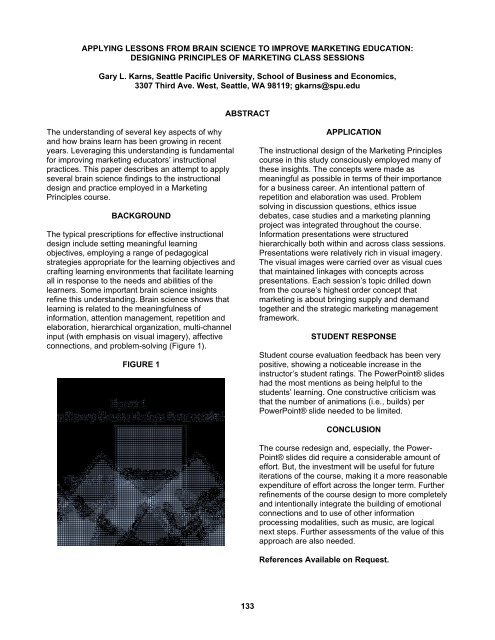2008 - Marketing Educators' Association
2008 - Marketing Educators' Association
2008 - Marketing Educators' Association
Create successful ePaper yourself
Turn your PDF publications into a flip-book with our unique Google optimized e-Paper software.
APPLYING LESSONS FROM BRAIN SCIENCE TO IMPROVE MARKETING EDUCATION:<br />
DESIGNING PRINCIPLES OF MARKETING CLASS SESSIONS<br />
Gary L. Karns, Seattle Pacific University, School of Business and Economics,<br />
3307 Third Ave. West, Seattle, WA 98119; gkarns@spu.edu<br />
The understanding of several key aspects of why<br />
and how brains learn has been growing in recent<br />
years. Leveraging this understanding is fundamental<br />
for improving marketing educators’ instructional<br />
practices. This paper describes an attempt to apply<br />
several brain science findings to the instructional<br />
design and practice employed in a <strong>Marketing</strong><br />
Principles course.<br />
BACKGROUND<br />
The typical prescriptions for effective instructional<br />
design include setting meaningful learning<br />
objectives, employing a range of pedagogical<br />
strategies appropriate for the learning objectives and<br />
crafting learning environments that facilitate learning<br />
all in response to the needs and abilities of the<br />
learners. Some important brain science insights<br />
refine this understanding. Brain science shows that<br />
learning is related to the meaningfulness of<br />
information, attention management, repetition and<br />
elaboration, hierarchical organization, multi-channel<br />
input (with emphasis on visual imagery), affective<br />
connections, and problem-solving (Figure 1).<br />
FIGURE 1<br />
ABSTRACT<br />
133<br />
APPLICATION<br />
The instructional design of the <strong>Marketing</strong> Principles<br />
course in this study consciously employed many of<br />
these insights. The concepts were made as<br />
meaningful as possible in terms of their importance<br />
for a business career. An intentional pattern of<br />
repetition and elaboration was used. Problem<br />
solving in discussion questions, ethics issue<br />
debates, case studies and a marketing planning<br />
project was integrated throughout the course.<br />
Information presentations were structured<br />
hierarchically both within and across class sessions.<br />
Presentations were relatively rich in visual imagery.<br />
The visual images were carried over as visual cues<br />
that maintained linkages with concepts across<br />
presentations. Each session’s topic drilled down<br />
from the course’s highest order concept that<br />
marketing is about bringing supply and demand<br />
together and the strategic marketing management<br />
framework.<br />
STUDENT RESPONSE<br />
Student course evaluation feedback has been very<br />
positive, showing a noticeable increase in the<br />
instructor’s student ratings. The PowerPoint® slides<br />
had the most mentions as being helpful to the<br />
students’ learning. One constructive criticism was<br />
that the number of animations (i.e., builds) per<br />
PowerPoint® slide needed to be limited.<br />
CONCLUSION<br />
The course redesign and, especially, the Power-<br />
Point® slides did require a considerable amount of<br />
effort. But, the investment will be useful for future<br />
iterations of the course, making it a more reasonable<br />
expenditure of effort across the longer term. Further<br />
refinements of the course design to more completely<br />
and intentionally integrate the building of emotional<br />
connections and to use of other information<br />
processing modalities, such as music, are logical<br />
next steps. Further assessments of the value of this<br />
approach are also needed.<br />
References Available on Request.


